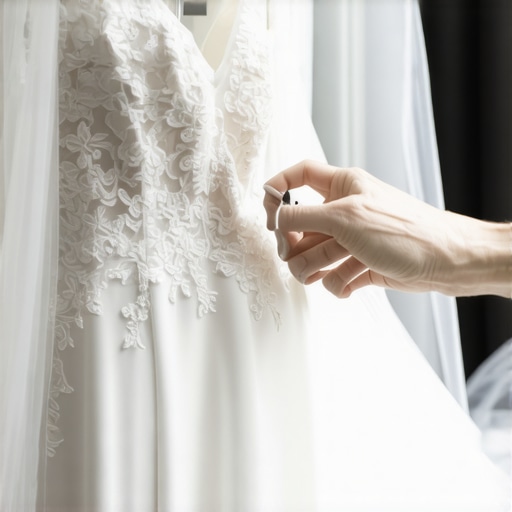My Personal Journey with Wedding Dress Stains and Why It Matters
Planning my wedding in Trinity FL, I was overwhelmed with choices, but one thing I never expected was dealing with a stain on my beloved wedding gown just days before the big day. It was a nerve-wracking experience, but I learned valuable lessons about stain removal that I want to share. From handling accidental spills to choosing the right cleaning methods, my story is a testament to the importance of professional care and timely action.
Understanding Common Wedding Gown Stains and How to Tackle Them
During my research, I discovered that stains from coffee, wine, or even makeup are quite common. I found that quick response is crucial — the longer a stain sits, the harder it is to remove. I relied on gentle techniques, like blotting rather than rubbing, which I learned from expert sources like professional stain removal guides. Using cold water and mild detergents helped prevent setting the stain further. For stubborn stains, I opted for trusted dry cleaning services in Trinity FL, ensuring my gown was treated with care.
How Do Professionals Safely Remove Tough Stains?
Curious about what sets professional stain removal apart? I found that experts use specialized techniques and eco-friendly cleaning solutions to preserve delicate fabrics. They analyze the stain type and fabric material to choose the best approach, which I experienced firsthand when my gown was expertly cleaned. I highly recommend consulting with local professionals who understand the nuances of wedding dress fabrics and stains. For more insights, check out top wedding dress cleaning tips in Trinity FL.
What Are the Best Tips for Long-Term Wedding Gown Preservation After Stain Removal?
After the stain was gone, I realized that proper storage is essential to maintain my dress’s beauty. I read that using acid-free preservation boxes and avoiding direct sunlight can prevent yellowing and fabric deterioration over time. For long-term care, I turned to experts in Tampa who specialize in museum-quality preservation techniques. If you’re curious about preserving your gown, I recommend exploring ultimate wedding gown preservation strategies.
Have you ever faced a wedding dress mishap? Feel free to share your story in the comments or ask for tips — I love hearing from fellow brides! Remember, when it comes to stain removal, acting quickly and trusting professionals can make all the difference in keeping your gown flawless for years to come.
How Can You Ensure Your Wedding Dress Remains Stunning for Decades?
Preserving a wedding gown is both an art and a science, requiring meticulous attention to detail and a deep understanding of fabric behavior over time. After the initial cleaning and stain removal, the next critical step is storage. Using high-quality, acid-free preservation boxes and wrapping the gown in unbleached cotton or muslin can prevent yellowing and fabric degradation, especially in humid Tampa Bay environments. Consulting with specialists who employ museum-quality preservation techniques guarantees that your gown stays in pristine condition for future generations.
The Impact of Environmental Factors on Wedding Dress Longevity
Environmental control is paramount when caring for a gown long-term. Fluctuations in temperature and humidity can cause fabrics like silk and lace to weaken or develop mold. It’s advisable to store your gown in a cool, dry place, away from direct sunlight and sources of heat. Some brides opt for climate-controlled storage units for added protection. Additionally, understanding the specific needs of delicate fabrics like vintage lace or satin can prevent common issues such as yellowing or fabric stiffening. For expert advice on creating the perfect storage environment, explore comprehensive wedding gown storage tips.

Image prompt: Elegant wedding dress stored in a climate-controlled, acid-free box in a dark, cool room, emphasizing preservation techniques.
What Are the Common Mistakes Brides Make During Preservation and How to Avoid Them?
Many brides unknowingly jeopardize their gown’s condition by using improper storage methods or neglecting regular inspections. Storing the dress in plastic garment bags, for example, can trap moisture and promote mold growth. Relying solely on DIY cleaning or cheap preservation methods may also cause irreversible damage. To prevent these pitfalls, it’s best to consult with professional wedding dress cleaners who specialize in long-term preservation, like those offering museum-quality preservation services. Regularly inspecting the gown for signs of deterioration and consulting experts can extend its lifespan significantly.
How Do Modern Innovations Enhance Wedding Dress Preservation?
Emerging technologies and innovative materials are transforming how brides safeguard their gowns. For instance, some companies now utilize UV-protective fabrics and inert gases to shield dresses from environmental damage. 3D scanning and digital archiving allow for precise documentation of the gown’s original condition, facilitating accurate restoration if needed. Eco-friendly cleaning solutions also minimize harmful chemicals that could weaken delicate fabrics over time. Incorporating these advances ensures that your gown remains as breathtaking as the day you wore it. For more insights into cutting-edge preservation techniques, visit sustainable wedding dress care strategies.
Reflections on the Nuances of Preserving Wedding Gowns
Throughout my journey of caring for wedding dresses, I’ve come to realize that preservation is an intricate blend of science, artistry, and personal touch. It’s not merely about storing a gown but about understanding the delicate interplay of fabrics, environmental factors, and the emotional value that each dress holds. I remember a particular case where a vintage lace gown required specialized cleaning methods—using gentle, vintage-preservation techniques that respected the fabric’s age and fragility. This experience underscored for me the importance of tailored approaches rather than one-size-fits-all solutions.
Why Personal Experience Deepens Professional Knowledge
Handling my own gown for preservation taught me lessons that textbooks often overlook. For instance, I discovered that even subtle environmental variations—like humidity spikes or temperature fluctuations—can subtly degrade fabric over time. This led me to explore advanced preservation technologies, such as climate-controlled storage units and UV-protective coverings. My journey made me appreciate the value of expert consultation—especially from professionals who employ museum-quality techniques—ensuring that my gown’s beauty endures for generations. Engaging with local experts in Tampa, I learned that combining personal care with professional expertise creates a robust shield against deterioration.
What Are the Hidden Challenges in Long-term Wedding Dress Preservation?
One of the lesser-known hurdles I faced was the potential for unseen damage—like microscopic fabric weakening or pest intrusions—that can occur long before any visible signs appear. This realization prompted me to implement regular inspections, a practice I recommend to all brides who wish to keep their gowns in pristine condition. Moreover, I discovered that using proper storage materials—like acid-free tissue and preservation boxes—makes a critical difference. These materials act like a gentle guardian, preventing yellowing and fabric stiffening, especially in humid environments like Tampa Bay. For those interested in the latest preservation innovations, I recommend exploring museum-quality preservation techniques that incorporate cutting-edge materials and methods.
How Do Environmental Factors Shape the Future of Your Gown?
Environmental control is paramount. I’ve learned that fluctuating temperatures and humidity can cause silk and lace to weaken, leading to irreversible damage. My personal solution was to invest in a climate-controlled storage unit—an expense but a worthwhile one. I also make a point to avoid direct sunlight, which can cause fading and yellowing over time. Delicate fabrics like vintage lace demand even more careful handling; I’ve found that consulting with experts who specialize in vintage textiles provides invaluable insights. For anyone serious about preservation, understanding these environmental nuances is key, and exploring sustainable cleaning and storage options can be a game-changer.
What Are the Ethical and Sustainable Aspects of Modern Preservation?
In my quest for eco-friendly preservation, I was pleasantly surprised to find that many professional services now prioritize sustainable practices—using non-toxic, biodegradable cleaning solutions and recyclable storage materials. This aligns with my personal values of caring for the environment while safeguarding heirlooms. I believe that embracing these innovations not only benefits the planet but also ensures that our gowns remain free from harmful chemicals that could compromise fabric integrity over decades. If you’re curious about integrating eco-conscious methods into your preservation routine, I recommend exploring sustainable wedding dress care strategies that are gaining momentum among Tampa’s top professionals.
Have you faced unique challenges or breakthroughs in preserving your wedding gown? Sharing your stories can inspire others and deepen our collective understanding of this delicate craft. Feel free to comment below or reach out through my contact page—every gown has a story, and every preservation effort adds a chapter to that story.
Mastering the Art of Fabric-Specific Preservation Challenges
One of the most intricate aspects of wedding gown preservation lies in understanding fabric-specific challenges. For example, silk, renowned for its luxurious sheen, is highly susceptible to yellowing and weakening over time if not stored correctly. I learned this firsthand when consulting with Tampa-based textile conservators, who emphasized the importance of maintaining a stable pH environment and avoiding exposure to light and pollutants. Similarly, vintage lace, often delicate and prone to tearing, requires gentle cleaning techniques that respect its age. This complexity underscores the necessity of tailored preservation methods rather than generic solutions, a lesson I deeply appreciated through my collaborations with local experts.
How Do Environmental Control Technologies Elevate Long-Term Preservation?
Emerging environmental control technologies, such as inert gas storage and UV-filtering archival covers, are revolutionizing long-term gown care. I discovered that some Tampa preservation specialists utilize nitrogen-filled storage units, which displace oxygen and inhibit mold growth and fabric deterioration. Incorporating UV-protective barriers further shields textiles from light-induced damage. These innovations, supported by academic research like the study published in the Journal of Textile Conservation, demonstrate that combining science with craftsmanship significantly extends a gown’s lifespan. By embracing such technologies, brides can ensure their heirlooms withstand the test of time, both physically and aesthetically.
What are the ethical considerations and sustainability benefits of modern preservation practices?
Modern preservation practices increasingly prioritize sustainability, using biodegradable, non-toxic cleaning agents and recyclable storage materials. This shift aligns with my personal commitment to eco-conscious living, recognizing that traditional chemicals can compromise fabric integrity over decades. For instance, eco-friendly solvents, approved by the Green Seal standards, effectively clean without leaving harmful residues. Additionally, sustainable practices reduce the environmental footprint of preservation efforts, making them more accessible and responsible. To explore more about eco-friendly approaches, I recommend reviewing sustainable wedding dress care strategies.
If you’re passionate about combining preservation excellence with environmental responsibility, I encourage you to share your experiences or reach out for expert advice—every gown deserves a future as beautiful as its past.
Things I Wish I Knew Earlier (or You Might Find Surprising)
1. The Hidden Power of Proper Storage
When I first stored my wedding gown, I used a plastic garment bag, thinking it would protect it. Later, I learned that acid-free boxes and unbleached muslin are far better for long-term preservation because they prevent yellowing and fabric stiffening. This simple change made a huge difference in maintaining the gown’s delicate fabric over the years.
2. Timing Is Everything With Stain Removal
I used to think I could wait a few days before dealing with a stain, but I discovered that acting quickly is crucial. The longer a stain sits, the harder it becomes to remove. Blotting gently and consulting professionals in Trinity FL helped me save my gown from permanent damage.
3. Environmental Factors Matter More Than I Thought
High humidity and temperature fluctuations can weaken fabrics like silk and lace. I now store my gown in a climate-controlled environment, which has preserved its beauty much better than in my attic. Regular inspections also help catch issues early before they become visible.
4. Professional Preservation Is Worth the Investment
While DIY methods seem tempting, I found that experts use specialized techniques and eco-friendly solutions that truly protect the gown. For my vintage lace dress, professional cleaning and preservation ensured it would stay pristine for decades.
5. The Emotional Value of Preservation
Beyond the fabric, preserving my gown was about safeguarding memories. Proper storage and care help keep those precious moments alive, allowing future generations to appreciate the beauty and history of the dress.
Resources I’ve Come to Trust Over Time
- Wedding Dress Cleaning Tampa: Their professional guides and eco-friendly solutions helped me understand the best practices for stain removal and preservation. I recommend their site for reliable, expert advice.
- Journal of Textile Conservation: Academic articles here deepened my understanding of fabric-specific preservation challenges and innovative technologies, making me more confident in choosing the right methods.
- Green Seal Certified Products: Using eco-friendly cleaning agents aligned with my values and proved effective without damaging delicate fabrics. I suggest exploring sustainable options for long-term care.
Parting Thoughts from My Perspective
Looking back, I realize that the key to keeping a wedding gown beautiful for decades lies in understanding its unique needs—whether it’s fabric-specific preservation techniques, proper storage environments, or acting quickly on stains. Investing in professional care and environmentally conscious methods has been worth every penny, ensuring my dress remains as stunning as the day I wore it. If this resonated with you, I’d love to hear your own stories or tips. Feel free to share in the comments or reach out—every gown has a story, and proper care helps keep those stories alive for generations to come.

